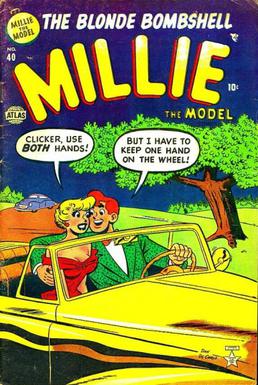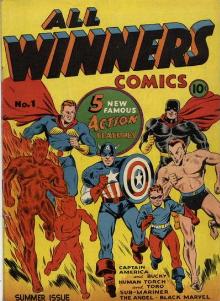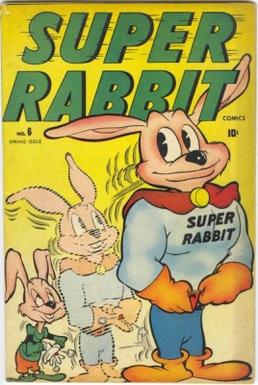
Timely Comics is the common name for the group of corporations that was the earliest comic book arm of American publisher Martin Goodman, and the entity that would evolve by the 1960s to become Marvel Comics.

Patricia "Patsy" Walker is a superhero appearing in American comic books published by Marvel Comics. Created by Stuart Little and Ruth Atkinson, Patsy Walker first appeared in Miss America Magazine #2, published by Marvel precursor Timely Comics, and became Hellcat in The Avengers #144. She premiered as the star of a teen romantic-comedy series, and was later integrated into Marvel superhero franchises such as the Avengers and the Defenders as Hellcat.

Miss America is a superhero appearing in American comic books published by Marvel Comics. Created by writer Otto Binder and artist Al Gabriele, the character first appeared in Marvel Mystery Comics #49 in the Golden Age of Comic Books. Madeline Joyce is the first incarnation of Miss America. The character has also been a member of the Invaders, Liberty Legion, and All-Winners Squad at various points in her history.

All Select Comics is a 1943–1945 American comic book series published by Timely Comics, the 1940s predecessor of Marvel Comics, during the period fans and historians call the Golden Age of comic books. An omnibus series with several different superhero and other features each issue, it primarily starred Captain America and the original Human Torch, two of Timely's most popular characters, as well as fellow Timely star the Sub-Mariner in several.

The Angel is a fictional superhero appearing in American comic books published by Marvel Comics. Created by artist Paul Gustavson and an unconfirmed writer during the Golden Age of Comic Books, the Angel first appeared in Marvel Comics #1, the first publication of Marvel Comics' predecessor, Timely Comics.

Vision (Aarkus) is a superhero appearing in American comic books published by Marvel Comics. Created by the writer Joe Simon and artist Jack Kirby, the character first appeared during the Golden Age of comic books in Marvel Mystery Comics #13, published by Marvel predecessor Timely Comics.

The All-Winners Squad is a fictional superhero team appearing in American comic books published by Marvel Comics. The company's first such team, it first appeared in All Winners Comics #19, published by Marvel predecessor Timely Comics during the period fans and historians call the Golden Age of Comic Books.

Atlas Comics was the 1950s comic-book publishing label that evolved into Marvel Comics. Magazine and paperback novel publisher Martin Goodman, whose business strategy involved having a multitude of corporate entities, used Atlas as the umbrella name for his comic-book division during this time. Atlas evolved out of Goodman's 1940s comic-book division, Timely Comics, and was located on the 14th floor of the Empire State Building. This company is distinct from the 1970s comic-book company, also founded by Goodman, that is known as Atlas/Seaboard Comics.

Millie the Model was Marvel Comics' longest-running humor title, first published by the company's 1940s predecessor, Timely Comics, and continuing through its 1950s forerunner, Atlas Comics, to 1970s Marvel. The comic book series deals with Millie Collins, an aspiring model working for the Hanover Modeling Agency.

The Blazing Skull is a fictional character appearing in American comic books published by Marvel Comics. The character was created during the Golden Age of Comic Books by Marvel's predecessor, Timely Comics, and first appeared in Mystic Comics #5. The character's writer and artist creators are unknown. The Blazing Skull fell into obscurity after the 1940s, and was revived in the 1990s.
Phantom Eagle is the name used by two fictional aviator heroes appearing in American comic books.

Betsy Ross is a character appearing in American comic books published by Marvel Comics. Created by Joe Simon and Jack Kirby, the character first appeared in Captain America Comics #1. Betsy Ross is Captain America's early love interest and supporting character in American comic books published by Marvel Comics during the 1930-1940s period known to historians and collectors as the Golden Age of Comic Books. She then debuted as the superheroine Golden Girl in Captain America Comics #66.

Father Time is a fictional superhero appearing in American comic books published by Marvel Comics. The character was created by writer Stan Lee and artist Al Avison and first appeared in Captain America Comics #6, published by Marvel predecessor Timely Comics during the period fans and historians call the Golden Age of comic books. He was one of the many costumed operatives who were recruited into the United States military.

Blue Diamond is a fictional superhero appearing in American comic books published by Marvel Comics, debuting under the company's 1940s forerunner, Timely Comics. The character was created in 1941 by Ben Thompson, who also drew the first comic book adventures of Ka-Zar the Great and Citizen V for Timely, as well as the Masked Marvel for Centaur Publications and Dr. Frost for Prize Comics.

Isbisa is a fictional supervillain appearing in American comic books published by Marvel Comics. He first appeared in All Winners Comics vol. 1, #19, published by Marvel predecessor Timely Comics during the 1940s period fans and historians call the Golden Age of Comic Books. He was created by writer Bill Finger and one or more of the five artists who contributed one or more chapters to his 44-page debut story.

All Winners Comics was the name of two American comic book series of the 1940s, both published by Marvel Comics' predecessor, Timely Comics, during the period fans and historians call the Golden Age of Comic Books. A superhero anthology comic in both cases, they variously featured such star characters as Captain America, the original Human Torch, and the Sub-Mariner. All Winners Comics was also the venue for two full-length stories of Marvel's first superhero team, the (hyphenated) All-Winners Squad.

U.S.A. Comics was an American comic-book series published by Marvel Comics' 1930–1940s predecessor, Timely Comics, during the period fans and historians call the Golden Age of comic books.

Super Rabbit is a talking animal superhero in american comic books published by Timely Comics, a predecessor of Marvel Comics, during the 1930s and 1940s period fans and historians call the Golden Age of comic books. Created by cartoonist Ernie Hart, he first appeared in Comedy Comics #14.

The Whizzer is a superhero appearing in American comic books published by Marvel Comics. He first appeared during the period called the Golden Age of Comic Books.
Mystic Comics is the name of three comic book series published by the company that eventually became Marvel Comics. The first two series were superhero anthologies published by Marvel's 1930-1940s predecessor, Timely Comics, during what fans and historians call the Golden Age of comic books. The third, simply titled Mystic, was a horror fiction-suspense anthology from Marvel's 1950s forerunner, Atlas Comics.



















